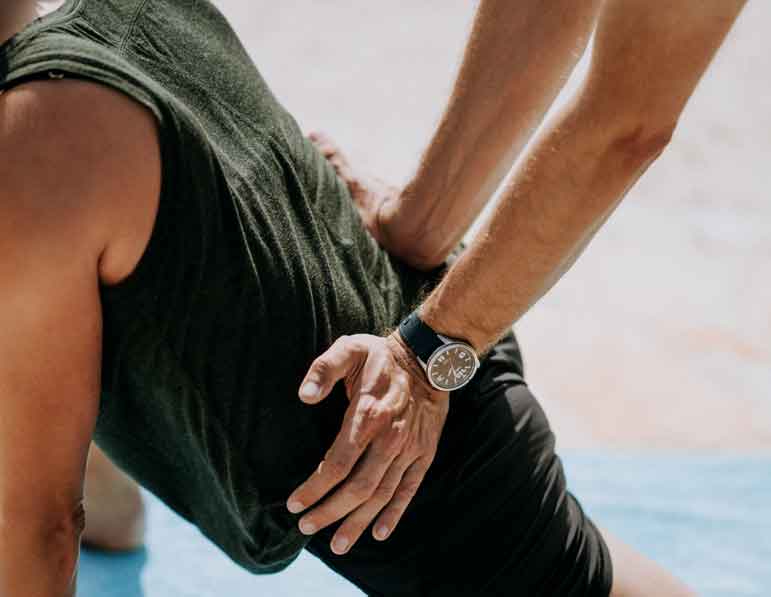
You might expect to feel out of shape, and you probably gird yourself for the sore muscles you'll have after that first real workout.
What is that soreness all about? Is it an indicator of damage or of growth? And how should you deal with muscle soreness - should you rest or keep moving?
The muscle soreness that emerges the day after a workout is called delayed-onset muscle soreness - or DOMS - by exercise scientists. "DOMS is a normal process of muscle adaptation to some unfamiliar movement," says Heather Vincent, a sports medicine specialist and the director of the University of Florida's Health Sports Performance Center.
The movement may be unfamiliar because you haven't done that workout in months or because you've upped your intensity.
Pain and tenderness in the overworked muscles generally peak between 24 and 72 hours after the activity. It's a drawn-out series of physiological events in and around the muscle.
DOMS occurs with a particular type of movement - one that loads your muscles while they are long or lengthening. These are called eccentric movements, Vincent says, "such as lowering a weight from a biceps curl or lowering into a squat." In my case, it's my quads as I climb down a mountain. In contrast, DOMS generally doesn't occur with isometric (when the muscle doesn't change length) or concentric (when the muscle shortens) movement.
When your muscles are not accustomed to the movement - or the weight or endurance of the movement - your muscle fibers undergo mechanical stress and small breaks occur in their membranes.
Keith Baar, professor of physiology and membrane biology at the University of California at Davis, explains that muscles are made up of muscle fibers connected to each other by proteins called dystrophyns, which function like rivets. When the muscle is accustomed to work, the rivets help the individual muscle fibers work as a well-choreographed team to move the body.
Without training however, Baar says, "these connections are weak. So when you do exercise, they slide and shear." The rivets pull at the membranes, making tiny tears. This causes a number of chemical events in the muscle, including dysregulated fiber contractions, an influx of immune cells, and swelling and pressure buildup.
This may sound bad, but Vincent reminds me, "This is normal." The repair process not only fixes the tears but also helps the muscle to strengthen, to be better prepared for similar movement in the future.
"The inflammation is necessary to help you regenerate the injured muscle," Baar says. "When you're starting a new exercise program, you may have more painful days."
In addition, older people's muscles tend to undergo more damage than younger people. So as you age, Baar says, "You're more likely to get sore with exercise and the resulting DOMS is more extended."
To prevent soreness, people should work up slowly to the activity they want to do. In the gym, you might start with body weight only, before you start adding external weights. I might do sets of squats or lunges before heading out for my first all-day hike of the summer. These incremental steps help your muscles adapt more slowly and with less resulting pain.
Once you've triggered DOMS, however, Baar encourages you to rest while the process plays out. "Take the time to recover," he says. This is not a time for the 'no pain, no gain' mantra.
What about relief, as with ice or over-the-counter pain relievers? Either treatment may lessen your discomfort, but they're not advised. That's because of the dual nature of delayed-onset muscle soreness - it's both a process of repair and of building strength. "If you block DOMS, the muscle doesn't grow as much," Baar says.
An exception can be made for athletes who are scheduled to compete on a day they're experiencing muscle soreness. That's because in addition to causing discomfort and pain, DOMS interferes with athletic performance. The athlete may give preference to the day's performance rather than to her long-term gain in strength.
Studies have examined whether manipulating worked muscles after a training session affects their resulting soreness. A small 2015 study reported some promise for foam rolling - using one's body weight to massage the muscle with rolling pressure. Eight men spent 20 minutes using a foam roller immediately after a workout, and then again 24 and 48 hours later. The practice reduced the amount of soreness at 24 and 48 hours; the performance deficits that accompanied DOMS were also reduced.
A 2021 study with 20 men and women found that foam rolling immediately following a workout mitigated the performance deficit 24 hours later, but had no effect on pain.
Of foam rolling, Vincent says, "It sounds gimmicky, but it does work for some people." She speculates that massaging the muscles may improve blood flow and help move excess fluid out. "And there don't appear to be downsides, unlike ibuprofen."
The main thing to know, Vincent says, is that muscle soreness is not in itself a bad thing. "Everyone, even elite athletes can experience DOMS," she says.
(COMMENT, BELOW)


 Contact The Editor
Contact The Editor
 Articles By This Author
Articles By This Author